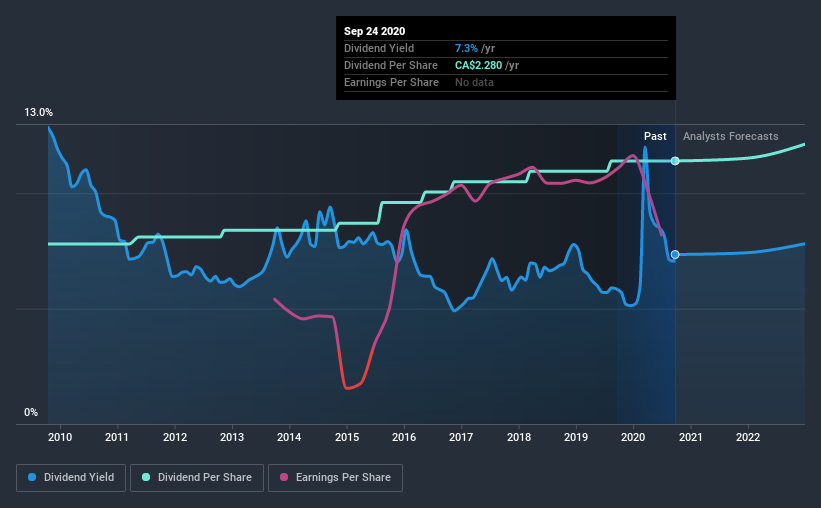Here's Why We're Wary Of Buying Exchange Income's (TSE:EIF) For Its Upcoming Dividend

Readers hoping to buy Exchange Income Corporation (TSE:EIF) for its dividend will need to make their move shortly, as the stock is about to trade ex-dividend. Ex-dividend means that investors that purchase the stock on or after the 29th of September will not receive this dividend, which will be paid on the 15th of October.
Exchange Income's upcoming dividend is CA$0.19 a share, following on from the last 12 months, when the company distributed a total of CA$2.28 per share to shareholders. Based on the last year's worth of payments, Exchange Income has a trailing yield of 7.3% on the current stock price of CA$31.04. We love seeing companies pay a dividend, but it's also important to be sure that laying the golden eggs isn't going to kill our golden goose! So we need to investigate whether Exchange Income can afford its dividend, and if the dividend could grow.
Check out our latest analysis for Exchange Income
Dividends are usually paid out of company profits, so if a company pays out more than it earned then its dividend is usually at greater risk of being cut. Exchange Income paid out 150% of profit in the past year, which we think is typically not sustainable unless there are mitigating characteristics such as unusually strong cash flow or a large cash balance. Yet cash flows are even more important than profits for assessing a dividend, so we need to see if the company generated enough cash to pay its distribution. Exchange Income paid out more free cash flow than it generated - 181%, to be precise - last year, which we think is concerningly high. We're curious about why the company paid out more cash than it generated last year, since this can be one of the early signs that a dividend may be unsustainable.
Cash is slightly more important than profit from a dividend perspective, but given Exchange Income's payouts were not well covered by either earnings or cash flow, we would be concerned about the sustainability of this dividend.
Click here to see the company's payout ratio, plus analyst estimates of its future dividends.
Have Earnings And Dividends Been Growing?
Companies with consistently growing earnings per share generally make the best dividend stocks, as they usually find it easier to grow dividends per share. If earnings decline and the company is forced to cut its dividend, investors could watch the value of their investment go up in smoke. For this reason, we're glad to see Exchange Income's earnings per share have risen 12% per annum over the last five years. It's great to see earnings per share growing rapidly, but we're disturbed to see the company paid out 150% of its earnings last year. We're wary of fast-growing companies flaming out by over-committing themselves financially, and consider this a yellow flag.
We'd also point out that Exchange Income issued a meaningful number of new shares in the past year. It's hard to grow dividends per share when a company keeps creating new shares.
Another key way to measure a company's dividend prospects is by measuring its historical rate of dividend growth. In the past 10 years, Exchange Income has increased its dividend at approximately 3.9% a year on average. It's good to see both earnings and the dividend have improved - although the former has been rising much quicker than the latter, possibly due to the company reinvesting more of its profits in growth.
Final Takeaway
Is Exchange Income worth buying for its dividend? Earnings per share have been growing, despite the company paying out a concerningly high percentage of its earnings and cashflow. We struggle to see how a company paying out so much of its earnings and cash flow will be able to sustain its dividend in a downturn, or reinvest enough into its business to continue growing earnings without borrowing heavily. With the way things are shaping up from a dividend perspective, we'd be inclined to steer clear of Exchange Income.
Having said that, if you're looking at this stock without much concern for the dividend, you should still be familiar of the risks involved with Exchange Income. To that end, you should learn about the 3 warning signs we've spotted with Exchange Income (including 2 which make us uncomfortable).
If you're in the market for dividend stocks, we recommend checking our list of top dividend stocks with a greater than 2% yield and an upcoming dividend.
This article by Simply Wall St is general in nature. It does not constitute a recommendation to buy or sell any stock, and does not take account of your objectives, or your financial situation. We aim to bring you long-term focused analysis driven by fundamental data. Note that our analysis may not factor in the latest price-sensitive company announcements or qualitative material. Simply Wall St has no position in any stocks mentioned.
Have feedback on this article? Concerned about the content? Get in touch with us directly. Alternatively, email editorial-team@simplywallst.com.

 Yahoo Finance
Yahoo Finance 
